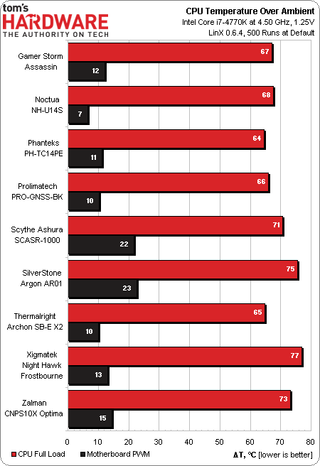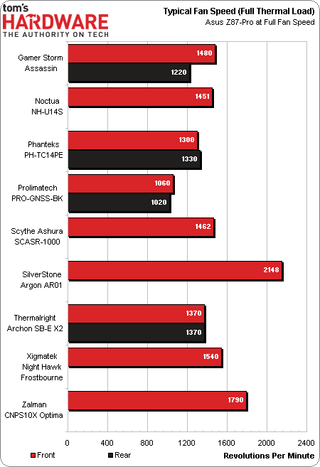Nine Big Air Coolers For Intel's Haswell CPUs, Reviewed
Intel's Haswell-based CPUs have a unique cooling problem that leaves many overclockers in a quandary. Today, we're rounding up nine different sink and fan combinations to see if any can contend with the fourth-gen Core processor's copious heat.
Results: Cooling And Fan Speed
The most noticeable feature of our temperature charts is the narrow range of approximately 12° between highest and lowest CPU core temperatures. Dismantled Core i7-4770s suggest that this is due to the interface material Intel uses. At best, this shows that huge improvements in cooling technology are needed to create relatively small drops in temperature.

The results are also the average of all four highest temperatures, and some cores run hotter than others.
Scythe’s Ashura is the hottest cooler to stay under the processor’s 100° limit at a room temperature of 23°. Zalman’s CNPS10X Optima failed the test at just over 21° room temperature, and hours of extra A/C were required to get the room cold enough to finish Argon AR01 and Night Hawk Frostbourne measurements.

We might have blamed Xigmatek’s white paint for the cooler’s inability to cope with a Haswell-based CPU at a mere 1.25 V, if not for the audible cues to fan speed. The slower speed likely corresponds to less airflow, though fin design is also a potential factor.
Current page: Results: Cooling And Fan Speed
Prev Page Test Settings And Benchmarks Next Page Noise And Acoustic EfficiencyStay On the Cutting Edge: Get the Tom's Hardware Newsletter
Join the experts who read Tom's Hardware for the inside track on enthusiast PC tech news — and have for over 25 years. We'll send breaking news and in-depth reviews of CPUs, GPUs, AI, maker hardware and more straight to your inbox.
-
jk_ventolero The CM H212 Evo has been a crowd favorite for quite some time now. :) I wonder how that might have performed. :DReply -
blackmagnum Water cooling is the best way forward: less noise, energy efficient and low maintenance.Reply -
CaptainTom I hate to say it but all this article demonstrated to me is that Haswell is in no way better than Ivy Bridge. Even Ivy Bridge used 25% less energy with a 10% boost when compared to Sandy Bridge, and I can still get IB to 4.8 GHz on air.Reply
Haswell= 10% more power for 10% more energy and 10% less headroom. Oh and it costs more...
Man I hope AMD can whip them back into shape with Steam Roller... -
s3anister I can't even fathom why one would spend this much time to write an article like this and still leave the NH-D14 out.Reply -
spazoid It's funny how some of you guys still think Intel made Haswell with desktops in mind. This is a CPU architecture made for mobile. It's quite sufficient for desktops in every regard. Yes, it might not outperform IB by much, and it might run a bit hotter, but in a laptop, there is nothing that compares to Haswell.Reply -
Crashman Reply
Noctua picked the NH-U14S instead of the D14. Please feel free to ask them why.11158600 said:No NH D14?
Since Noctua chose not to feature the NH-D14 this time, you might want to look at its closest competitor. The article links a comparison of Phanteks TCP14E and NH-D14. Since Phanteks chose to keep its big cooler in the running but Noctua chose otherwise, this was the closest "frame of reference" available.
I can't even fathom why you would repeat the first post without regard to any response. And speaking of a response, please read above.11159094 said:I can't even fathom why one would spend this much time to write an article like this and still leave the NH-D14 out.
-
Shneiky Really disappointed that there was no be quiet! and Cooler Master representatives. I would enjoy seeing how a Dark Rock Pro 2 or a V8 GTS/V6 GT.Reply -
flong777 The comments are correct concerning the omission of the NH-D14 from this testing. It really doesn't matter a damn what "Noctua picked," that is not the issue. The FACT is the D14 is legendary for its cooling and to leave it out of any major test is just plain stupid. Don't forget that it won your last competition for best cooler.Reply
To say compare it's performance with the Plantek's performance is lame. Use some common sense when you do these reviews.

